
FLOWERS AND THEIR SPIRITUAL SIGNIFICANCES
Flowers have been mediums for messages since time immemorial. In the Victorian era they were used as love notes to convey the deepest feelings between lover and beloved or to arrange assignations. Yet long before this flowers were offered to the gods as vehicles of prayer and devotion and they have been and remain today the chosen custom of expressing sorrow and reverence for the dead as well as traditional gifts on the occasions of births, weddings and anniversaries.
Do flowers have in them a special occult, i.e. hidden, capacity to convey our deepest feelings or have we made them so because of their beauty, color, form and fragrance. It is well known in India that the flower of devotion offered to the Divine, is ‘tulsi’, Ocimum tenuiflorum, known formerly as Ocimum sanctum, both named by the father of botany, Linnaeus. Therefore the question, has man imbued flowers with certain significances or do the flowers themselves vibrate with a special force that may be translated by those with a inner perception into meanings approachable to the mental consciousness?
Here are some answers from the Mother.
“In some countries (particularly here) certain plants are used as the media for worship, offering, devotion. Certain plants are given on special occasions. And I have often seen that this identification was quite in keeping with the nature of the plant, because spontaneously, without knowing anything, I happened to give the same meaning as that given in religious ceremonies. The vibration was really there in the flower itself…..Did it come from the use that had been made of it or did it come from very far, from somewhere deep down, from a beginning of the psychic life? It would be difficult to say.”
“It’s largely the fragrances that have made me give flowers their significance… I find these studies quite interesting; it corresponds to something really true in Nature.
Once, with telling me anything, somone brought me a sprig of tulsi (Ocimum sanctum). I smell it and said, “Oh, Devotion!” It was absolutely a . . . a vibration of devotion. Afterwards I was told it is the plant of devotion to Krishna, consecrated to Krishna.
Another time, I was brought one of those big flowers (which are not really flowers) somewhat resembling corn, with long, very strongly scented stalks [Spiritual Perfume]. I smelled it and said, Ascetic Purity! . . . just like that, from the odour alone. I was later told it was Shiva’s flower when he was doing his tapasya.
These people have an age-old knowledge which they have preserved. In other words, it is something concretely true: it doesn’t depend at all on the mind, on thought or even on feelings---it is a vibration . . .
Yes, this flower is Shiva, doing his tapasya.
And interestingly enough, its smell is fantastically attractive to snakes; it makes them come from far away to nest in the shrubs. And as you know, the serpent is the power of evolution, it is Shiva’s own creature; he always puts them on his head and around his neck because they symbolise the power of evolution and transformation. And snakes like this flower; it often grows near rivers, and where there is a cluster of the plants you are sure to discover snake nests.
I find this very interesting, for we didn’t decide it should be like this; these are conscious vibrations in Nature. The fragrance, the colour, the shape, are simply the generous expression of a true movement.”
If we look at the ‘common names’ of certain flowers we find they are often rather prosaic. It is quite simple to discern the most fundamental association based on a flower’s shape or its usage. Take for example the ‘Lady slipper orchid’. Its shape is very much like a lady’s slipper. No great profundity here for this terrestrial species. But what of the epiphytic orchids that are the most highly evolved of all plants, having risen from an earthly existence rooted in the soil to be able to grow and flower abundantly in extraordinary displays of thousands of shapes and colors and fragrances with the capacity to live only from the air and rain and whatever nutrients are supplied in the form of soluble organic matter from the branches of trees to which they are attached. Note how their roots attach themselves to the trees. The tree is their host, they take nothing from it. They are epiphytes, not parasites.

The Aim of Existence is Realised (Cattleya orchid)
Certainly these thousands of shapes and fragrances may resemble animals (the monkey orchids, birds or other creatures) but their beauty transcends any given name associated with something common or easily iderntified. The significance given to orchids by the Mother is powerful and transcendently beautiful, “Attachment to the Divine”. Mother has also given us a comment on the significance: “Wraps itself around the Divine and finds all its support in Him, so as to be sure of never leaving him.”
I have lived in the Sri Aurobindo Ashram and Auroville for many years, first coming to the Ashram in 1951, and have had the special blessing to work with hundreds of tropical flowers as in my youth I learned both temperate and sub-tropical horticulture in the U.S. In the early 1960’s I met the Mother who gave me a work in music and with plants, gave me Her Blessings (and a ‘Blessing Packet’ of flowers) to care for the ‘Service Tree’ over the Samadhi of Sri Aurobindo for the rest of my life. Some years later She asked me to build the Gardens of the Matrimandir at the center of a new township, Auroville, to be built on the ‘ideal of human unity’ and located approximately10 km north of the Ashram.
The Mother’s ability to disclose the essential vibration of a flower, its significance and the paramount importance of its message to humanity is a seminal work which will be the foundation of the future understanding of the force and profound symbolism that individual flowers convey to our consciousness and can indeed be vehicles for our spiritual growth.
Life must blossom like a flower offering itself to the Divine
The Mother

Day lily (Hemerocallis) Unnamed as yet.
Some questions asked of the Mother and Her replies.
“Have flowers a power in the occult world?
Mother: “Yes, they have an occult power; they can even transmit a message if one knows how to charge them with it.”
“Can flowers transmit other messages apart from the significances you have given?”
Mother: “It is not impossible but the person who sends the messge must have a great power of formation.”
Is the power of formation purely occult or can a mental or vital power of formation also transmit messages?”
Mother: “The mental power of formation can certainly transmit messages. But for these messages to be received and understood, the person to whom they are sent must himself be very receptive mentally and particularly attentive.”
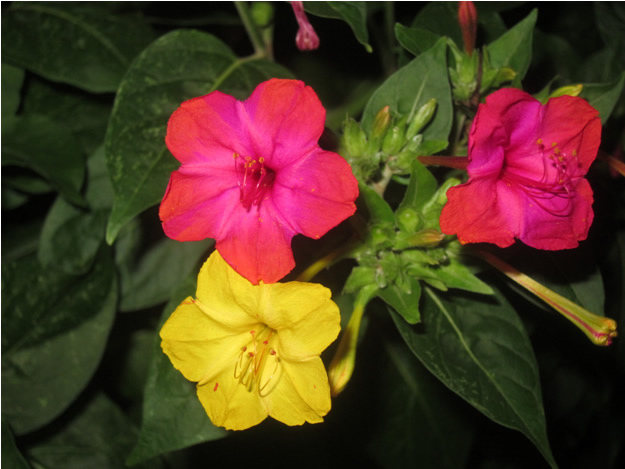
Solace (Mirabilis jalapa)
Here are some of the Mother’s replies on the inner meaning of flowers and the way in which she was able to approximate in words their essential vibration.
“Mother, when flowers are brought to you, how do you give them a significance? “
Mother: “By entering into contact with the nature of the flower, its inner truth. Then one knows what it represents.”
Mother, how do you give a significance to a flower?
Mother: “By entering into contact with it and giving a meaning, more or less precise, to what I feel.”
Mother, each flower has its own significance, doesn't it?
Mother: Not as we understand it mentally. There is a mental projection when one gives a precise significance to a flower. ... A flower does not have the equivalent of a mental consciousness. ... It is rather like the movement of a little baby, neither a sensation nor a feeling, but something of both; it is a spontaneous movement, a very special vibration. Well, if one is in contact with this vibration, if one feels it, one receives an impression which may be translated by a thought. This is how I give a significance to flowers and plants. There is a kind of identification with the vibration, a perception of the quality it represents, and gradually through a kind of approximation (sometimes it comes suddenly, occasionally it takes time) there is a convergence of these vibrations, which are of a vital-emotional order, and the vibration of mental thought, and if there is sufficient accord one has a direct perception of what the plant may signify.”
Further, the Mother has written and spoken at great length about flowers and the approximately 900 names she has given to them. Compilations are available in two books, Flowers and Their Messages and a two-volume work, The Spiritual Significance of Flowers.
"Flowers speak to us when we know how to listen to them it is a subtle and fragrant language."
The Mother
In addition to the significances given by the Mother, those who worked closely with flowers were given the opportunity to ask questions regarding the role of flowers in our lives. We will touch on these points later in this article.

Collective Emotions Open to the Divine (Mansoa alliacea – Garlic vine)
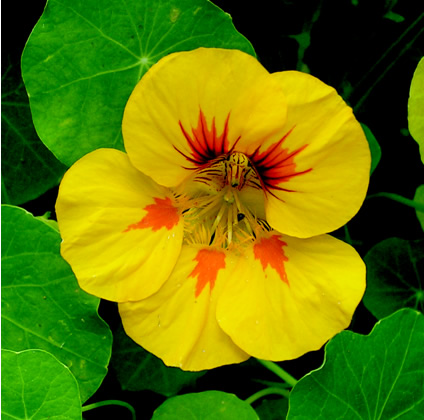
Promise of Realisation in the Physical Mind – (Tropaeolum – Nasturtium)
The great sage, poet and Avatar of the Supramental Age, Sri Aurobindo, was once asked the following about a flower to which the Mother gave his name, Portulaca grandiflora, the Rose moss or Sun plant, popular in the East as well as the West for the beauty of its colors, its prolific bloom and ability to grow and flower in the hottest climates. His reply carries in it a depth of meaning and a transcendent statement of the value of flowers in our lives.
“Why is the flower symbolising your compassion so delicate and why does it wither away so soon?”
Sri Aurobindo: “No, the compassion does not wither with its symbol - flowers are moment's representation of things that are in themselves eternal. “
For me, the supernal verities contained in his words, “flowers are the moment’s representation of things that are in themselves eternal” have been a fragrant portal into the inner being resulting in a deeper understanding of earth, her beauty and bounty and the chosen place for the realization of a divine life on earth.
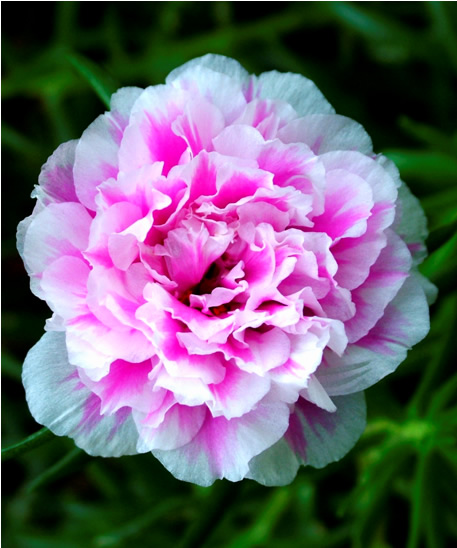
Sri Aurobindo’s Compassion (Portulaca grandiflora – one of the newer colours)
How then to attain a deeper contact with flowers? We are now in a visual age, where books are uploaded in Kindle and IPads and DVD’s on every imaginable subject are available to us as well as streaming media on computers. Botanical knowledge has increased dramatically with the advent of computers but we have laearned too of the work of plantsmen and women throughout the world whose love for flowers has enabled them to create hybrids of inexpressible beauty, fragrance, colour and form.
Here are some answers given by the Mother and a few of the great souls who have opened to us some of the secrets of plant life.
“What is the best way of opening ourselves to the deep influence of flowers”
Mother: “To love them. If you can enter in psychic contact with them, then that would be perfect.”
The rose speaks silently of love, in a language known only to the heart.
Anonymous
The love of flowers is really the best teacher of how to grow and understand them.
Max Schling
The above quotations speak to us of the way we can enter into this inner communion with flowers, through a contact with the heart or even deeper, with the psychic being, the evolving soul in us. Many have done it and have developed such a deep connection that they have been able to unlock the genetic secrets of many species and create new flowers of greater fragrance and beauty. A number of them have been ‘amateur gardeners’ working with love and devotion, unconcerned with the length of time taken to create something new. Is is essential for the future of humanity and the earth that man must learn to collaborate with and not attempt to dominate and subjugate Nature for his temporal needs and desires but to turn his energies into healing and not plundering and destroying the beauty of the earth.
Luther Burbank had such an intimate contact with plants that he could walk down a row of 10,000 fruit tree seedlings all approimately the same size and pick the two that would bear superior fruit.
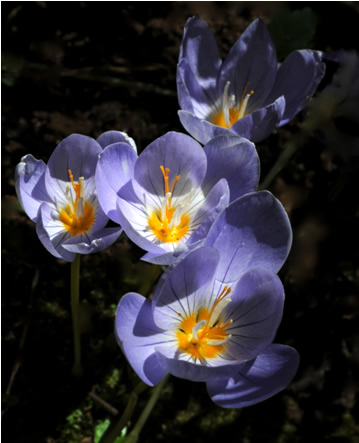
An autumn flowering crocus – unnamed as yet
So also, George Washington Carver unlocked the secrets of the humble peanut and discovered its innumerable uses. Here is one of his quotes:
“Anything will give up its secrets if you love it enough.”
George Washington Carver
The following two quotations by Antoine Saint.Exupéry and Sri Aurobindo speak of a different way of seeing.
“And now here is my secret, a very simple secret, it is only with the heart that one can see rightly; what is essential is invisible to the eye.”
Antoine Saint.Exupéry (Author of The Little Prince)
“When one has the vision in the heart, everything, Nature and Thought and Action, ideas and occupations and tastes and objects become beloved and are a source of ecstasy.
Sri Aurobindo
Deeper than the heart, behind it in fact, though more to the center is the psychic being. It is the contact of our psychic being with flowers that can enable us to clearly see and understand this incomparable gift of earth and the beauty of her flowers.
Two lines from Sri Aurobindo’s epic poem, Savitri:
Alive and clad with trees and herbs and flowers
Earth’s great brown body smiled towards the skies,
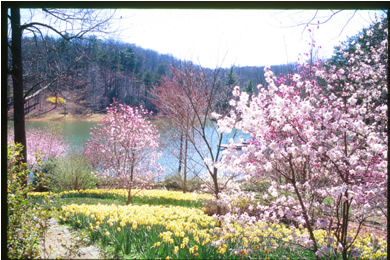
A view of Mother’s Garden in Georgia, U.S.A.
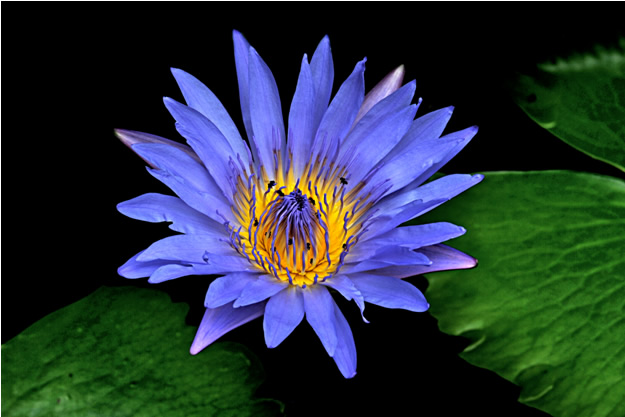
Wealth in the Mind of Light – (Nymphaea – Water lily)
Here are more words of the Mother.
Mother: “The plants are very psychic , but they can express it only by silence and beauty.
“Love of flowers in a valuable help for finding and uniting with the psychic”
You have written: “Love of flowers is a valuable help for finding and uniting with the psychic.” Could you explain this more in detail?
Mother: “Since flowers are the manifestation of the psychic in the vegetal kingdom, love of flowers would mean that one is drawn by the psychic vibration and consequently by the psychic in one’s own self.
When you are receptive to the psychic vibration, that puts you in a more intimate contact with the psychic in your own self. Perhaps the beauty of flowers too is a means used by Nature to awaken in human beings the attraction for the psychic.”
How can one enter in to a psychic contact with flowers?
Mother: “When one is in conscious contact with one’s own psychic, one becomes aware of an impersonal psychic behind the whole creation and the, through this, one can enter into contact with flowers and know the psychic prayer they represent.”
What is the psychic prayer that flowers represent?
Mother: “The psychic, when it manifests in a plant, in the form of a flower, is in the form of a wordless prayer; it is the élan of the plant towards the Divine.” 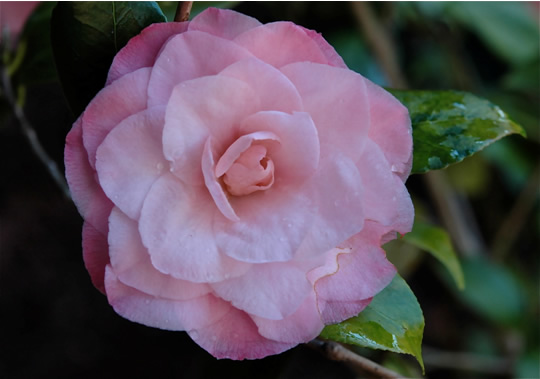
Static Beauty (Camellia sasanqua)
Comment by the Mother: “Transfixed in an immutable beauty.”
The following are a few questions I wrote to Mother and Her replies.
N. “There are many plants we are trying to grow here which suffer because of our climate. How can we help them to grow and blossom here?
Mother: “Naturally, plants which like cold climates would grow in greenhouses. Also by planting forests one could have a regulating action on the climate.
Growth of consciousness in the atmosphere will surely have an effect which it is difficult to describe beforehand.”
N. “Are there forces directly hostile to vegetal nature? Are insects a manifestation of these forces?
Mother: “There do not seem to exist forces consciously and voluntarily hostile to the vegetal kingdom. Insects to harm because they feed on plants, but in this way they serve them also; both things are there, good and bad, without any conscious will. They go good they do harm, without knowing it.?
N. If our flower-offering depends on our state of consciousness does it help us to learn the significances of flowers even it if is purely mental to begin with?
Mother: ‘Yes, surely.”
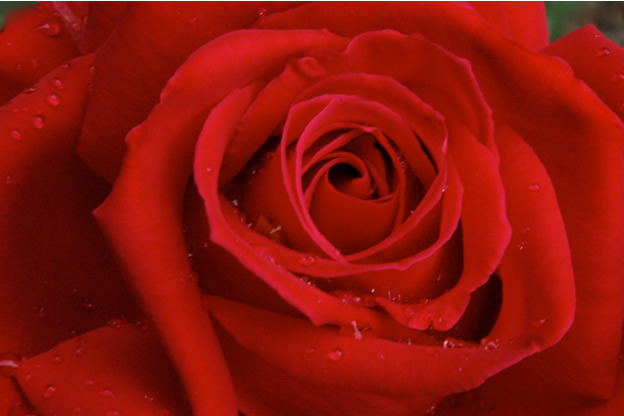
Human Passions Changed into Love for the Divine (Red rose)
We see now that flowers vibrate with a special significance, understandable to those who are in psychic contact with them. They speak to us when we know how to listen to them. Lewis Carroll, the brilliant mathematician and author of Alice in Wonderland, wrote in his book, Through the Looking Glass, Alice’s conversation with a flower; As I don’t recall the exact words I paraphrase.
`O Tiger-lily,’ said Alice, addressing herself to one that was waving gracefully about in the wind, `I wish you could talk!’
We can talk,’ said the Tiger-lily: `when there’s anybody around worth talking to.
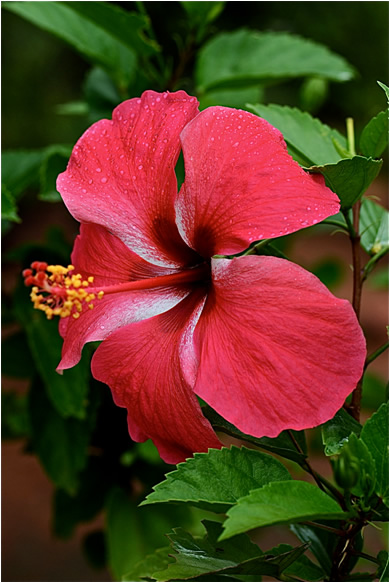
Aesthetic Power (Hibiscus rosa-sinensis)
The life of the enchanted globe became
A storm of sweetness and of light and song,
A revel of colour and of ecstasy,
A hymn of rays, a litany of cries:
A strain of choral priestly music sang
And, swung on the swaying censer of the trees,
A sacrifice of perfume filled the hours.
Asocas burned in crimson spots of flame,
Pure like the breath of an unstained desire
White jasmines haunted the enamoured air,
Pale mango-blossoms fed the liquid voice
Of the love-maddened coïl, and the brown bee
Muttered in fragrance mid the honey-buds.
The sunlight was a great god’s golden smile.
All Nature was at beauty’s festival.
Savitri

Power of Beauty (Narcissus – Daffodil)
(Photo from Mother’s Garden in Georgia, U.S.A.)
Those who through their inmost being, have entered deeply into contact with flowers – and there are many – have left us a wealth of quotations, writing poetically and reverentially about the beauty of flowers and their meaning in our lives. In a forthcoming book, Flowers for the Soul, I will share their words along with photographs of flowers in which it is hoped will reveal something of their inner beauty and significance.
I close with these inspiring passages from the Mother and two lines from Savitri.
Mother: “When I give flowers it is as an answer to the aspiration coming from the very depths of your being. It is a need or an aspiration, it depends on the person. It may fill a void or else give you the impetus to progress, or it may help you find the inner harmony in order to establish peace. Do you understand?
Be like a flower. One must try to become like a flower: open, frank, equal, generous and kind….
A flower is open to all that surrounds it: Nature, light, the rays of the sun, the wind, etc. It exerts a spontaneous influence on all that is around it. It radiates a joy and a beauty.
It is frank: It hides nothing of its beauty, and lets it flower frankly out of itself. What is within, what is in it depths, it lets it come out so that everyone can see it.
It is equal: it has no preference. Everyone can enjoy its beauty and its perfume, without rivalry. It is equal and the same for everybody. There is no difference, or anything whatsoever.
Then generous: without reserve or restriction, how it gives the mysterious beauty and the very own perfume of Nature. It sacrifices itself entirely for our pleasure, even its life it sacrifices to express this beauty and the secret of the things gathered within itself.
And then, kind: it as such tenderness, it is so sweet, so close to us, so loving. Its presence fills us with joy. It is always cheerful and happy.
Happy is he who can exchange his qualities with the real qualities of the flowers. Try to cultivate in yourself their refined qualities.
I give you flowers so that you may develop the Divine qualities they symbolise. And they can directly transmit into the psychic al that they contain, pure, unalloyed. Now, it seems to me that you wish to become like a flower or cultivate these qualities. And, you know, each flower symbolises an aspect, an emanation, an aspiration and a progress to the evolution of the earth.
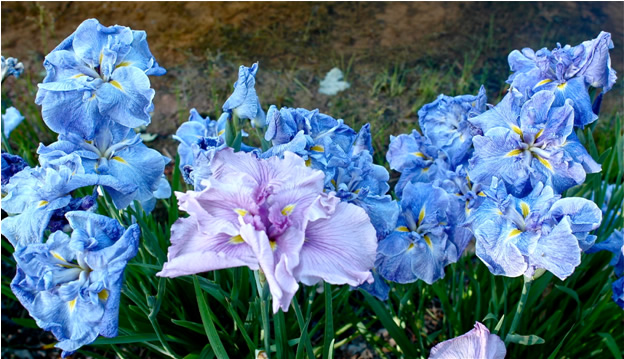
Aristocracy of Beauty (Iris – Japanense)
Mother: “The movement of love is not limited to human beings and it is perhaps less distorted I others worlds than in the human. Look at the flowers and trees. When the sun sets and all becomes silent, sit down for a moment and put yourself in communion with Nature: you will feel rising from the earth, from below the roots of the trees and mounting upward and coursing through their fibres up to the highest outstretching branches, the aspiration of an intense love and longing,—a longing for something that brings light and gives happiness, for the light that is gone ad they wish to have back again. There is a yearning so pure and intense that if you can feel the movement in the trees, your own being too will go up in an ardent prayer for the peace and light and love that are unmanifested here.
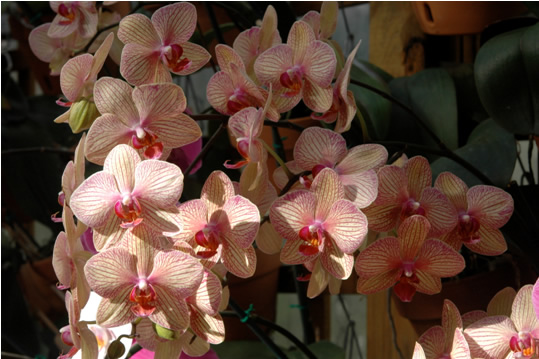
Attachment to the Divine – (Orchids)
His laughter of beauty breaks out in green trees,
His moments of beauty triumph in a flower
Savitri, Book X, Canto III
Narad (Richard Eggenberger)
Sri Aurobindo Ashram, Puducherry
November 2012